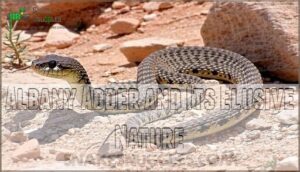This site is supported by our readers. We may earn a commission, at no cost to you, if you purchase through links.

This pattern repeats across continents: fewer than 50 Albany Adders are known to exist, and the Trang Blind Snake is missing in action—unseen since a single specimen was collected in 1960s Thailand. These critically endangered snakes face familiar threats—habitat loss, invasive predators, illegal trade—but also unexpected problems like disease outbreaks decimating their prey and climate change rendering their specialized homes uninhabitable.
Examining why these snakes are so vulnerable highlights the delicate balance within isolated ecosystems and the species that depend on them. Some conservation stories give us hope: the Antiguan Racer bounced back from 50 to over 1,100 individuals through concentrated efforts. Learning about these unusual species and the work being done to protect them illustrates how focused intervention can save species from extinction’s edge.
Table Of Contents
- Key Takeaways
- Rarest Snake Species Around The World
- Unique Characteristics of Rare Snakes
- Venomous Vs. Non-Venomous Rare Species
- Size, Coloration, and Camouflage
- Isolated Islands and Remote Regions
- Wetlands, Forests, and Grasslands
- Endemic Species and Their Limited Ranges
- Impact of Habitat Loss on Populations
- Habitat Destruction and Fragmentation
- Invasive Species and Introduced Predators
- Illegal Trade and Human Persecution
- Climate Change and Disease
- Snakebite First Aid and Public Awareness
- How Individuals Can Support Conservation
- Frequently Asked Questions (FAQs)
- Conclusion
Key Takeaways
- The world’s rarest snakes often survive in populations of fewer than 50 individuals, with the St. Lucian racer holding the record at under 20 snakes confined to a nine-hectare islet—though the Antiguan racer’s recovery from 50 to over 1,100 individuals proves that focused conservation can reverse extinction trajectories.
- Habitat destruction and invasive predators pose the greatest threats to rare snake populations, with documented cases showing 81% female population declines, over 85% wetland habitat loss in some regions, and introduced mongooses decimating entire Caribbean racer populations by preying on eggs and adults.
- Many of the world’s most endangered snakes are island endemics with ranges smaller than a single city block, making them exceptionally vulnerable since geographic isolation prevents dispersal, genetic exchange, and recovery from local disturbances or catastrophic events.
- Conservation success requires coordinated efforts including captive breeding programs, invasive species removal, habitat restoration, and public education—with citizen science, responsible tourism, and community involvement playing essential roles in protecting these species from extinction.
Rarest Snake Species Around The World
When you consider the world’s rarest snakes, you’re entering a space where populations sometimes dwindle to mere double digits—or where certain species haven’t been seen by scientists for decades.
From island racers barely holding on to existence to blind snakes known only from their original discovery, these serpents are facing possible extinction.
So which species sit at the edge of disappearing entirely?
St. Lucian Racer – The World’s Rarest Snake
You’ll find the rarest snake in the world clinging to survival on a tiny nine-hectare islet off Saint Lucia. The St Lucian racer faces extreme extinction risks, with fewer than 20 individuals documented in recent surveys.
Island isolation protects this population bottleneck from invasive species impact—mongooses devastated mainland populations in the 1800s. These non-venomous ambush predators show habitat dependence and diet specificity, feeding primarily on whiptail lizards in rocky scrubland.
The snake, also known as the ornate ground snake, is unique to the island. Conservation efforts now focus on captive breeding and predator-free reintroduction sites to secure the Saint Lucia racer’s survival.
Antiguan Racer – Conservation Success Story
The St. Lucian racer is still critically endangered, but the Antiguan racer tells a different story. Conservation work has pulled this species back from near extinction—just 50 snakes existed in 1995, but over 1,100 are around today.
Three key strategies drove this success: removing invasive species, restoring damaged habitats, and reintroducing racers to four islands:
Getting rid of invasive species, fixing habitats, and putting racers back on four islands made it happen:
- Black rat removal on Great Bird Island doubled the population within years
- Tracking the genetics of 591 snakes helps guide how we manage them
- Education campaigns improved how people see the snakes and encouraged community protection
Keeping habitats safe and continuing efforts to protect the snakes ensures this recovery sticks. The snakes are now located on four islands off Antigua.
Trang Blind Snake and Roxane’s Blind Snake
Some rare snakes disappear after just a quick sighting. Two of the rarest are the Trang blind snake and Roxane’s blind snake, both known from single specimens collected in Thailand during the 1960s. These fossorial species burrow underground, feeding on ant and termite larvae, making them nearly invisible to researchers. Their taxonomic placement within the family Typhlopidae reflects specialized adaptations for subterranean life.
Discovery circumstances were accidental: one was found beneath a rotting log near a waterfall, while the other was discovered in a Bangkok school garden. Habitat specificity and urban expansion pose significant conservation challenges, leaving their ecological role largely mysterious and their survival uncertain.
| Feature | Trang Blind Snake | Roxane’s Blind Snake |
|---|---|---|
| Length | 15.5 cm | Subadult female (similar size) |
| Scale Rows | 24 midbody | 20 midbody |
| Coloration | Gray-ultramarine dorsal, yellowish-white ventral | Dark pigment on upper 5 scale rows |
| Location | Trang Province, Thailand | Bangkok, Thailand |
| Last Seen | 1962 | 1963 |
Albany Adder and Its Elusive Nature
With critically endangered status and fewer than 50 known specimens worldwide, the Albany adder faces mounting pressure.
Mining operations and habitat loss threaten over two-thirds of its remaining territory, creating an urgent need for conservation action.
Classified as critically endangered, fewer than 50 specimens are known worldwide. Mining threats and habitat loss now endanger over two-thirds of its remaining range, making habitat protection urgent for these elusive adders. You’ll understand why population decline accelerates when you learn these details.
Other Notable Rare Snakes (Orlov’s Viper, Aruban Rattlesnake, Pfeffer’s Reed Snake)
Beyond the Albany adder, three more critically endangered species face severe threats. Orlov’s viper clings to survival in Russia’s Black Sea region, where fewer than 250 adults remain across less than 100 square kilometers of fragmented habitat. Poaching threats for the pet trade compound its decline.
The Aruban rattlesnake, endemic to just 12 square miles on Aruba, benefits from captive breeding programs despite human encroachment.
Pfeffer’s reed snake, restricted to two Japanese islands, exemplifies island endemism—isolation that magnifies extinction risk when development fragments already-limited terrain.
Unique Characteristics of Rare Snakes
These snakes have evolved remarkable adaptations that help them thrive in their specific environments.
From venom delivery systems tailored to their prey, to sensory abilities that make up for their limited range, each species demonstrates a unique survival strategy.
Here’s what sets these endangered snakes apart.
Let’s examine what makes these endangered snakes special.
Venomous Vs. Non-Venomous Rare Species
When you’re tracking down rare snakes, telling venomous from non-venomous species isn’t just about safety—it reveals how venom evolution shapes survival strategies. Of the roughly 725 venomous snake species worldwide, rare ones like the inland taipan have venom so potent that its LD₅₀ reaches 0.025 mg/kg, while more than 3,175 non-venomous species depend on mimicry instead.
Here are some key differences:
- Venom potency and dietary impact: Venomous rare snakes developed toxins aimed at their main prey, with the makeup shifting greatly based on snake habitats and available food.
- Mimicry tactics in non-venomous species: Milk snakes copy coral snake colors, and gopher snakes act like rattlesnakes—good defenses without needing toxins.
- Bias in reptile care: Reptile care often favors charismatic species, but both venomous and non-venomous rare reptiles face the same dangers from habitat loss and climate change.
Knowing these adaptations helps you see why protecting different snake species is important for a stable ecosystem.
Size, Coloration, and Camouflage
From the tiny Barbados threadsnake, a mere 10 centimeters long, to the immense green anaconda, stretching over 9 meters, snake sizes vary dramatically. This directly affects how these reptiles hunt, hide, and survive.
Scale patterns and colors work together; pigments across the visible spectrum fashion camouflage, from disruptive patterns on forest snakes to solid colors on desert dwellers. Pattern development mirrors snake habitats. Coloration helps with heat absorption, warning predators, and ambushing prey, depending on the species.
Most people assume snakes can’t hear anything since they don’t have external ears, but these reptiles actually sense sound vibrations through specialized bones in their jaw and skull—though researchers still aren’t entirely sure how the process works.
You might think snakes are deaf because they lack external ears, but they’ve evolved clever ways to detect sound vibrations that scientists are still working to fully understand.
Snakes can pick up airborne frequencies through specialized jaw and skull bones, though the exact mechanism remains a sensory mystery.
This vibrational sense helps them navigate their habitats, identify prey, and avoid threats.
Snakes bring their young into the world in one of two ways: some give live birth, while others lay eggs.
Either way, mother snakes typically stay close to guard their newborns during those critical early days.
Snake reproduction follows two main paths: some species bear live young, while others lay eggs. In both cases, mothers often protect their vulnerable offspring.
Egg-laying offers benefits such as lower energy expenditure for the mother, but live birth can place greater metabolic burdens on her. Factors like temperature and moisture influence these evolutionary pressures across snake species, shaping their behavior and determining whether females produce eggs or live offspring.
You’ll find the world’s rarest snakes in some pretty unexpected places—tiny islands no one’s heard of, wetlands tucked away from civilization, forests so thick they might as well be on another planet.
Here’s what determines where these elusive serpents end up—and why they can’t just pack up and move somewhere new.
These isolated habitats shape everything about how these species survive, from what they eat to how far they can spread.
Let’s look at where the world’s rarest snakes make their homes and why their ranges are so limited.
Isolated Islands and Remote Regions
When a snake’s entire world is confined to a few square miles of rocky coastline or a single forested island, every threat is magnified. Island endemism offers both refuge and increased risk—the world’s most endangered snakes are often found in these isolated havens, where geographic separation has led to unique reptile evolution.
The St. Lucian racer ekes out its existence on Maria Major, while the Antiguan racer tenaciously holds on to Great Bird Island. These examples of habitat specificity and limited distribution highlight why focused protection programs are so vital for these species to survive.
Wetlands, Forests, and Grasslands
Beyond the isolation of remote islands, rare snakes also need mainland ecosystems like wetlands, forests, and grasslands. Each habitat type poses unique survival challenges and requires specific conservation efforts.
Wetland destruction has devastated species like the giant garter snake, while habitat degradation in forests threatens March’s palm pit viper populations. These habitats nurture not just reptile species but countless organisms through species interdependence.
Because of ongoing habitat loss, ecological restoration and conservation management are vital for effective snake conservation.
Endemic Species and Their Limited Ranges
Many of the world’s rarest snakes are island snake endemics, trapped by geography in ranges smaller than a single city block. If you examine these species’ microhabitat specialization, you’ll see why conservation challenges are so severe:
- The Saint Lucia racer survives on just 12 hectares with fewer than 20 individuals
- Golden lancehead vipers are confined to one Brazilian island with 2,000–4,000 snakes
- Asian blind snakes occupy ranges under 100 km², some never found beyond their discovery site
- The Sardinian grass snake’s occupancy declined by half between 1985 and 2006
- Population bottlenecks threaten genetic viability, as harvesting just 25–40 golden lanceheads annually could cause extinction within a century
Range fragmentation compounds these problems. When rare reptiles are unable to disperse beyond isolated patches, habitat loss becomes catastrophic. You’re witnessing reptile species on the edge, where a single disturbance event could trigger total collapse.
That’s why snake conservation must address both the tiny spaces these endemics occupy and the threats closing in around them.
Impact of Habitat Loss on Populations
Habitat loss reshapes survival prospects for rare snakes in measurable ways. Female populations declined by 81% and males by 64% under escalating anthropogenic pressures, with fragmentation reducing dispersal and genetic exchange. Wetland conversion eliminated over 85% of California’s Central Valley aquatics, while deforestation increased snakebite incidence by up to 45%—a sign of displaced populations.
Take note of these documented effects:
| Threat Type | Population Impact |
|---|---|
| Habitat fragmentation | Reduced dispersal, elevated extinction risk |
| Deforestation effects | 21.7–45.2% rise in human-snake conflict |
| Wetland conversion | >85% range loss for aquatic specialists |
| Agricultural expansion | Range contractions, prey depletion |
| Urban sprawl | Simultaneous crashes from the late 1990s onward |
By 2050, 71% of threatened snake ranges will overlap high-density human zones—a 22% jump from today. Extinction trends show no recovery in nearly all crash-affected populations, highlighting how habitat destruction drives species endangerment. Threats to snake populations compound when you add roads, invasive predators, and climate shifts to already-fragmented landscapes.
Rare snakes face mounting pressures that push them closer to disappearing forever. When multiple threats hit at once, populations often can’t bounce back fast enough.
Rare snakes are facing increasing threats that drive them toward extinction. These dangers often combine, creating conditions where populations struggle to recover. Here’s what’s endangering these unique species.
Habitat Destruction and Fragmentation
A forest takes time to regrow, and for uncommon snakes, habitat destruction and fragmentation are devastating. Over 85% of wetland habitats are gone from California’s Central Valley, which has caused a dramatic decline in the giant garter snake population.
When habitats are lost, populations become isolated, leading to genetic isolation and reduced species survival rates. Fragmentation prevents access to key sites needed for thermoregulation and mating, while exposure to contaminants from nearby development poisons their food.
These ecosystem effects spread, disrupting food chains and further endangering snake species. Protecting habitats isn’t optional; it’s the critical support these populations need.
Invasive Species and Introduced Predators
Introduced predators have devastating ripple effects that you can’t ignore. For example, Asian mongooses and rats decimated Caribbean racer populations by eating their eggs and adult snakes. In Florida, Burmese pythons caused a 99% drop in mammal populations within a decade.
Furthermore, invasive species spread diseases like snake lungworm across 29 counties. These predation events disrupt ecosystems, mitigation is incredibly challenging, and without action, species survival is at risk.
Illegal Trade and Human Persecution
While habitat loss and species survival are major priorities, the illegal pet trade and snake trafficking drive vulnerable species toward extinction faster than you might think. Over 6.2 million CITES-listed snakes were involved in global trade from 1975 to 2018, with pythons being the most frequently trafficked.
Snake protection faces enforcement issues, as persecution directly impacts populations—10 of 14 radiotracked king cobras in Thailand died from human-caused actions.
Poaching and trafficking also create zoonotic risks through diseased animals entering markets, jeopardizing both snake endangerment and public health.
Climate Change and Disease
As global temperatures climb, climate change triggers climate-driven extinctions by shrinking suitable ranges—over 52% of reptile conservation targets face severe habitat loss and species survival pressures by 2070.
Disease vector shifts compound the crisis: chytridiomycosis devastates amphibian prey, cascading into snake declines, while habitat-borne illness spreads faster in fragmented landscapes.
Snakebite epidemiology also shifts as venomous species migrate into new regions, demanding urgent conservation redesign to protect both uncommon snake species and public health.
Threatened snakes need our help, and conservation efforts around the world are stepping up to protect them. These programs can’t succeed without public awareness, education, and your support.
Here’s what these programs are doing—and how you can be part of the solution.
Protecting threatened snakes requires focused action, and you can help. Worldwide programs are working to safeguard these species, but success hinges on awareness, education, and individual backing.
Let’s explore how these initiatives are making a difference and how you can get involved.
Real progress comes from concrete efforts. Captive breeding programs have been making a difference—since 2010, they’ve released about 350 eastern indigo snakes back into Alabama and Florida.
Meanwhile, land recovery projects have restored over 30 acres of habitat for San Francisco garter snakes.
Hope lies in focused action. Since 2010, captive breeding programs have released around 350 eastern indigo snakes into Alabama and Florida. Land recovery work has also reclaimed over 30 acres for San Francisco garter snakes.
Radiotelemetry tracks snake reproduction for species monitoring, and international groups like Save The Snakes funded 23 projects across 16 countries in 2021.
Programs that ease conflicts, such as Venomous Snake Response Teams, connect human safety with reptile protection. Groups like the Durrell Wildlife Conservation Trust advance land safeguarding through partnerships that fight snake endangerment worldwide.
Protection starts with understanding. When you know what you’re dealing with, fear gives way to respect—and eventually, a real drive to protect these creatures.
Reptile courses cover the essentials: how to handle snakes safely, the basics of venom research, and field identification techniques that keep both you and the animals safe.
You can’t protect what you don’t understand. Education bridges that gap, turning fear into a desire to conserve. Reptile courses teach safe snake-handling practices, basic venom research, and how to identify snakes in the field.
These programs transform curious individuals into citizen scientists who monitor populations and boost conservation awareness in their communities. Reptile education resources ensure the advantages of reptile courses are available to anyone wanting to help endangered species survive.
Snakebite First Aid and Public Awareness
Knowing how to respond when a snake bites someone can mean the difference between a full recovery and a medical emergency. First Aid Steps matter: keep calm, immobilize the limb, and get to a hospital for Antivenom Access and Venom Identification.
Avoid Snakebite Myths like tourniquets or sucking out venom.
Community Education programs teach Snake Safety and Snake Awareness, helping people recognize Venomous Snakes and respond correctly—turning panic into protection.
How Individuals Can Support Conservation
Beyond learning to handle a bite, you can take steps that directly help snakes survive in the wild. Back initiatives for Snake Preservation and Wildlife Protection through:
- Citizen Science – report sightings to track populations
- Habitat Improvement – volunteer for local Habitat Safeguard projects
- Responsible Pet Ownership – never release exotic snakes
When you understand snakes better, you’re more likely to protect them.
- Sustainable Consumption – reduce your environmental footprint
Snake Education turns concern into action.
Frequently Asked Questions (FAQs)
How do snakes digest prey after swallowing whole?
When carnivorous snakes swallow prey whole, their digestive enzymes function in an acidic environment to break down flesh and even bones.
Their slow metabolism and particular intestinal adaptations enable this impressive digestion across diverse ecosystem roles.
What evolutionary advantages do blind snakes possess?
Blind snakes are exceptionally well-adapted to life underground, thanks to their efficient burrowing and scaleless bodies.
Though they lack strong senses, they’re adept at finding prey by detecting chemical signals. This allows these snake species to flourish in subterranean environments where there’s less competition.
Can rare snakes be kept as pets legally?
Most uncommon snakes are prohibited as pets by law. The fact that snake species are endangered often restricts private ownership altogether.
Due to the impact on conservation and ethical factors, captive breeding programs are vital, and permit and licensing prerequisites differ greatly depending on the species and location.
How long do endangered snake species typically live?
The lifespan of endangered snake species differs considerably, depending on factors like genetic diversity, environmental pressures, and the impact of captivity.
Habitat loss and declining populations reduce reproductive rates, increasing the risk of extinction, even with rescue initiatives.
What role do snakes play in their ecosystems?
Snakes act as ecosystem engineers, keeping prey populations in check and providing sustenance for larger predators. Their presence impacts both nutrient cycling and habitat structure.
As indicators of biodiversity, snake species and their habitats reflect environmental health, making efforts to protect snakes vital for maintaining balanced plant and animal communities.
If you want to save snakes from disappearing, start by spreading the word about rare snake species in your corner of the world—or anywhere else, really.
Take the tough-as-nails Antiguan Racer or the struggling Albany Adder: they’re living proof that we can turn extinction around.
Conclusion
Protecting snakes begins with sharing information about uncommon snake species with communities around the globe. These fascinating reptiles—from the hardy Antiguan Racer to dwindling Albany Adders—show us that extinction can be avoided.
By protecting habitats, managing invasive species, and providing educational outreach, you can help make conservation successes commonplace instead of unusual. Whether you support projects in the field or simply learn more about these threatened animals, your involvement is important for preserving Earth’s vulnerable snakes for generations to come.
- https://www.jaborejob.com/top-10-rarest-snakes-in-the-world/
- https://museum.wales/blog/2046/The-Rarest-Snake-in-the-World/
- https://www.fauna-flora.org/countries/saint-lucia/
- https://kids.kiddle.co/Saint_Lucia_racer
- https://timesofindia.indiatimes.com/etimes/trending/saint-lucia-racer-is-the-rarest-snake-on-earth-discover-its-traits-unique-facts-and-more/articleshow/118581675.cms












